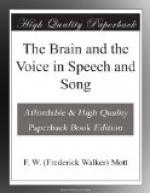PSYCHIC MECHANISM OF THE VOICE
A musical speaking voice denotes generally a good singing voice, and it must be remembered that articulation cannot be separated from phonation in the psychic mechanism. In speaking, we are unconscious of the breath necessary for the production of the voice. Not so, however, in effective singing, the management of the breathing being of fundamental importance; and it is no exaggeration to say that only the individual who knows how to breathe knows how to sing effectually. A musical ear and sense of rhythm are innate in some individuals; in others they are not innate and can only be acquired to a variable degree of perfection by persevering efforts and practice. The most intelligent persons may never be able to sing in tune, or even time; the latter (sense of rhythm) is much more easily acquired by practice than the former (correct intonation). This is easily intelligible, for rhythmical movement appertains also to speech and other acts of human beings, e.g. walking, dancing, running, swimming, etc.; moreover, rhythmical periodicity characterises the beat of the heart and respiration.
But how does a trained singer learn to sing a song or to take part in an opera? He has to study the performances of two parts for the vocal instrument—the part written by the composer and the part written by the poet or dramatist—and in order to present an artistic rendering, the intellectual and emotional characters of each part must be blended in harmonious combination. A singer will first read the words and understand their meaning, then memorise them, so that the whole attention subsequently may be given to applying the musical part to them and employing with proper phrasing, which means more than knowing when to breathe; it means imparting expression and feeling. A clever actor or orator can, if he possess a high degree of intelligence and a fairly artistic




